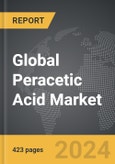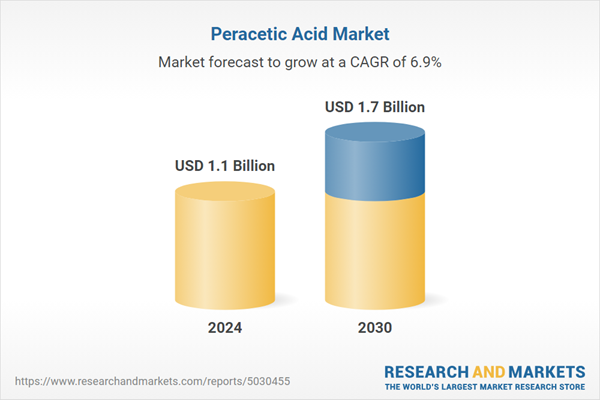The global market for Peracetic Acid was valued at US$1.1 Billion in 2024 and is projected to reach US$1.7 Billion by 2030, growing at a CAGR of 6.9% from 2024 to 2030. This comprehensive report provides an in-depth analysis of market trends, drivers, and forecasts, helping you make informed business decisions. The report includes the most recent global tariff developments and how they impact the Peracetic Acid market.
Segments: Application (Disinfectants, Sanitizers, Sterilants, Other Applications); End-Use (Food & Beverage, Healthcare, Water Treatment, Pulp & Paper, Other End-Uses).
Geographic Regions/Countries: World; USA; Canada; Japan; China; Europe; France; Germany; Italy; UK; Spain; Russia; Rest of Europe; Asia-Pacific; Australia; India; South Korea; Rest of Asia-Pacific; Latin America; Argentina; Brazil; Mexico; Rest of Latin America; Middle East; Iran; Israel; Saudi Arabia; UAE; Rest of Middle East; Africa.
The analysts continuously track trade developments worldwide, drawing insights from leading global economists and over 200 industry and policy institutions, including think tanks, trade organizations, and national economic advisory bodies. This intelligence is integrated into forecasting models to provide timely, data-driven analysis of emerging risks and opportunities.
Global Peracetic Acid Market - Key Trends & Drivers Summarized
How Is Peracetic Acid Revolutionizing Industrial Disinfection?
Peracetic acid (PAA) has become a cornerstone in industrial disinfection due to its potent biocidal properties and environmentally friendly profile. It is extensively used in the food and beverage industry for sanitizing equipment, containers, and surfaces to maintain hygiene standards and prevent contamination. Unlike other disinfectants, PAA decomposes into harmless by-products, acetic acid, water, and oxygen, posing minimal environmental hazards. This property, coupled with its efficacy at low concentrations, makes it an ideal choice for industries aiming to balance high sanitary standards with environmental sustainability. The growing emphasis on food safety and stringent regulations are driving the increased adoption of PAA in food processing and packaging sectors.What Makes Peracetic Acid a Preferred Choice for Water Treatment?
In water treatment, peracetic acid is favored for its effectiveness in eliminating pathogens and organic contaminants without producing harmful chlorinated by-products. Municipalities and industrial facilities are increasingly adopting PAA for wastewater treatment due to its rapid action and non-toxic degradation products. Its ability to work efficiently across a range of pH levels and temperatures enhances its versatility and applicability in various water treatment scenarios. Additionally, PAA's ease of application and the reduced need for secondary disinfection steps streamline the treatment process, making it cost-effective. The shift towards sustainable and safe water treatment practices is propelling the demand for peracetic acid in this sector.How Are Technological Advancements Enhancing Peracetic Acid Usage?
Technological advancements have significantly enhanced the production, stability, and application methods of peracetic acid, broadening its industrial utility. Innovations in production techniques have resulted in more stable and concentrated PAA solutions, improving their efficacy and shelf-life. Advanced packaging solutions and automated dosing systems have simplified its usage, enhancing safety and precision in various applications. Furthermore, the development of real-time monitoring technologies allows for better control and optimization of PAA dosing, ensuring maximum effectiveness with minimal waste. These technological improvements are particularly beneficial in sectors such as healthcare, where PAA is used for sterilizing medical equipment and surfaces, ensuring high standards of hygiene and infection control.What Factors Are Driving the Growth in the Peracetic Acid Market?
The growth in the peracetic acid market is driven by several factors. The increasing demand for high-level disinfectants in the food and beverage industry to comply with stringent hygiene regulations is a primary driver. In the healthcare sector, the necessity for effective sterilization methods to combat hospital-acquired infections is boosting PAA usage. Technological advancements that enhance the production and application efficiency of PAA are making it more accessible and user-friendly, encouraging its adoption. Regulatory support for environmentally benign disinfectants is also propelling the market forward. Additionally, the rising awareness of waterborne diseases and the need for sustainable water treatment solutions are significant factors fueling the demand for PAA. The compound's versatility and efficiency in various industrial applications ensure its growing relevance in the global market.Report Scope
The report analyzes the Peracetic Acid market, presented in terms of units. The analysis covers the key segments and geographic regions outlined below.Segments: Application (Disinfectants, Sanitizers, Sterilants, Other Applications); End-Use (Food & Beverage, Healthcare, Water Treatment, Pulp & Paper, Other End-Uses).
Geographic Regions/Countries: World; USA; Canada; Japan; China; Europe; France; Germany; Italy; UK; Spain; Russia; Rest of Europe; Asia-Pacific; Australia; India; South Korea; Rest of Asia-Pacific; Latin America; Argentina; Brazil; Mexico; Rest of Latin America; Middle East; Iran; Israel; Saudi Arabia; UAE; Rest of Middle East; Africa.
Key Insights:
- Market Growth: Understand the significant growth trajectory of the Disinfectants segment, which is expected to reach US$792.1 Million by 2030 with a CAGR of a 7.1%. The Sanitizers segment is also set to grow at 6.6% CAGR over the analysis period.
- Regional Analysis: Gain insights into the U.S. market, valued at $298.3 Million in 2024, and China, forecasted to grow at an impressive 10.2% CAGR to reach $262.0 Million by 2030. Discover growth trends in other key regions, including Japan, Canada, Germany, and the Asia-Pacific.
Why You Should Buy This Report:
- Detailed Market Analysis: Access a thorough analysis of the Global Peracetic Acid Market, covering all major geographic regions and market segments.
- Competitive Insights: Get an overview of the competitive landscape, including the market presence of major players across different geographies.
- Future Trends and Drivers: Understand the key trends and drivers shaping the future of the Global Peracetic Acid Market.
- Actionable Insights: Benefit from actionable insights that can help you identify new revenue opportunities and make strategic business decisions.
Key Questions Answered:
- How is the Global Peracetic Acid Market expected to evolve by 2030?
- What are the main drivers and restraints affecting the market?
- Which market segments will grow the most over the forecast period?
- How will market shares for different regions and segments change by 2030?
- Who are the leading players in the market, and what are their prospects?
Report Features:
- Comprehensive Market Data: Independent analysis of annual sales and market forecasts in US$ Million from 2024 to 2030.
- In-Depth Regional Analysis: Detailed insights into key markets, including the U.S., China, Japan, Canada, Europe, Asia-Pacific, Latin America, Middle East, and Africa.
- Company Profiles: Coverage of players such as Acuro Organics Limited, Biosan, LLC, California Soda Company, Diversey, Inc., Ecolab Inc. and more.
- Complimentary Updates: Receive free report updates for one year to keep you informed of the latest market developments.
Some of the 62 companies featured in this Peracetic Acid market report include:
- Acuro Organics Limited
- Biosan, LLC
- California Soda Company
- Diversey, Inc.
- Ecolab Inc.
- Enviro Tech Chemical Services, Inc.
- Evonik Industries AG
- Kemira OYJ
- Lenntech B.V.
- Mitsubishi Gas Chemical Company, Inc.
- Seeler Industries Inc
- Solvay SA
- Tanfac Industries Ltd
- The Vincit Group
Tariff Impact Analysis: Key Insights for 2025
Global tariff negotiations across 180+ countries are reshaping supply chains, costs, and competitiveness. This report reflects the latest developments as of April 2025 and incorporates forward-looking insights into the market outlook.The analysts continuously track trade developments worldwide, drawing insights from leading global economists and over 200 industry and policy institutions, including think tanks, trade organizations, and national economic advisory bodies. This intelligence is integrated into forecasting models to provide timely, data-driven analysis of emerging risks and opportunities.
What’s Included in This Edition:
- Tariff-adjusted market forecasts by region and segment
- Analysis of cost and supply chain implications by sourcing and trade exposure
- Strategic insights into geographic shifts
Buyers receive a free July 2025 update with:
- Finalized tariff impacts and new trade agreement effects
- Updated projections reflecting global sourcing and cost shifts
- Expanded country-specific coverage across the industry
Table of Contents
I. METHODOLOGYMII. EXECUTIVE SUMMARY2. FOCUS ON SELECT PLAYERSIII. MARKET ANALYSISCANADACHINAFRANCEGERMANYITALYUNITED KINGDOMSPAINRUSSIAREST OF EUROPEAUSTRALIAINDIASOUTH KOREAREST OF ASIA-PACIFICLATIN AMERICAARGENTINABRAZILMEXICOREST OF LATIN AMERICAAFRICAIV. COMPETITION
1. MARKET OVERVIEW
3. MARKET TRENDS & DRIVERS
4. GLOBAL MARKET PERSPECTIVE
UNITED STATES
JAPAN
EUROPE
ASIA-PACIFIC
MIDDLE EAST
Companies Mentioned (Partial List)
A selection of companies mentioned in this report includes, but is not limited to:
- Acuro Organics Limited
- Biosan, LLC
- California Soda Company
- Diversey, Inc.
- Ecolab Inc.
- Enviro Tech Chemical Services, Inc.
- Evonik Industries AG
- Kemira OYJ
- Lenntech B.V.
- Mitsubishi Gas Chemical Company, Inc.
- Seeler Industries Inc
- Solvay SA
- Tanfac Industries Ltd
- The Vincit Group
Table Information
| Report Attribute | Details |
|---|---|
| No. of Pages | 423 |
| Published | April 2025 |
| Forecast Period | 2024 - 2030 |
| Estimated Market Value ( USD | $ 1.1 Billion |
| Forecasted Market Value ( USD | $ 1.7 Billion |
| Compound Annual Growth Rate | 6.9% |
| Regions Covered | Global |









